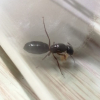The title pretty much says everything.
- Formiculture.com
- Forums
- Gallery
- Members
- Member Map
- Chat

The title pretty much says everything.
Yes, I know Dolichovespula and Vespula include socially parasitic species, at least in NA. Not sure about the rest of the world, but I imagine they exist there too.
Hi there! I went on a 6 month or so hiatus, in part due, and in part cause of the death of my colonies.
However, I went back to the Sierras, and restarted my collection, which is now as follows:
Aphaenogaster uinta, Camponotus vicinus, Camponotus modoc, Formica cf. aserva, Formica cf. micropthalma, Formica cf. manni, Formica subpolita, Formica cf. subaenescens, Lasius americanus, Manica invidia, Pogonomyrmex salinus, Pogonomyrmex sp. 1, Solenopsis validiuscula, & Solenopsis sp. 3 (new Sierra variant).
Vespula squamosa is parasitic in most cases, their hosts being V. maculifrons, and they can get many workers. It isn't obligatory though.
Edited by NickAnter, July 17 2022 - 8:55 AM.
Hi there! I went on a 6 month or so hiatus, in part due, and in part cause of the death of my colonies.
However, I went back to the Sierras, and restarted my collection, which is now as follows:
Aphaenogaster uinta, Camponotus vicinus, Camponotus modoc, Formica cf. aserva, Formica cf. micropthalma, Formica cf. manni, Formica subpolita, Formica cf. subaenescens, Lasius americanus, Manica invidia, Pogonomyrmex salinus, Pogonomyrmex sp. 1, Solenopsis validiuscula, & Solenopsis sp. 3 (new Sierra variant).
squamosa is a faculative social parasite, and are perfectly capable of founding a nest on their own. They usually do it because it is advantageous, not because they have to in order to survive.Vespula squamosa is parasitic in most cases, their hosts being V. maculifrons, and they can get many workers. It isn't obligatory though.
0 members, 0 guests, 0 anonymous users